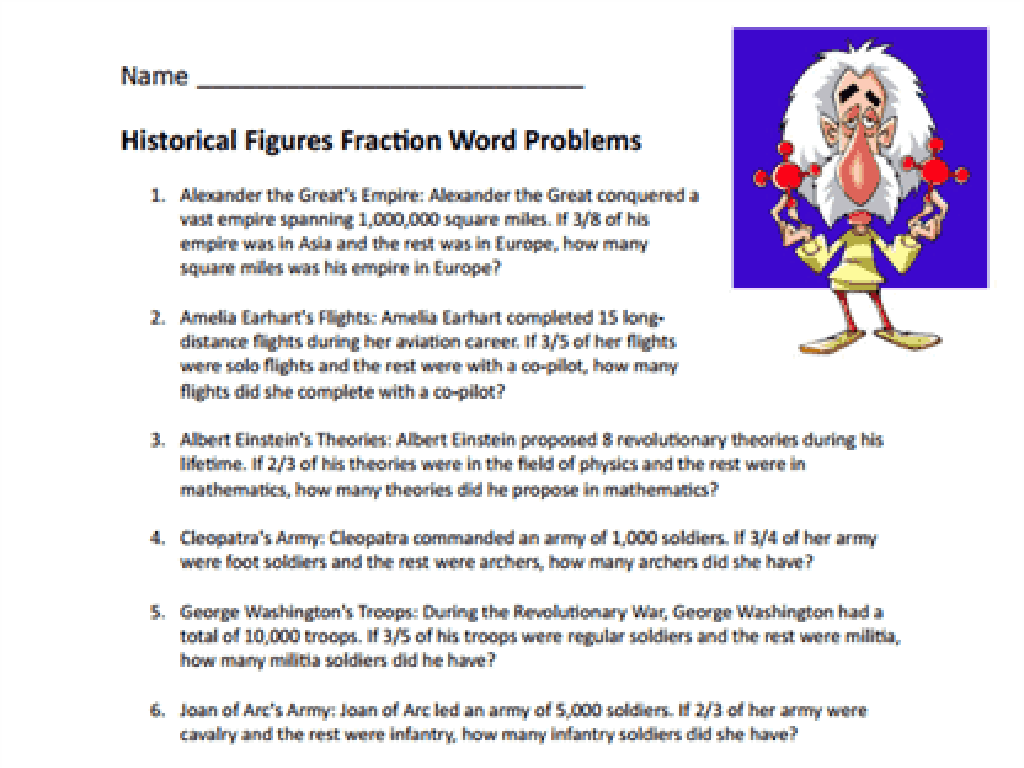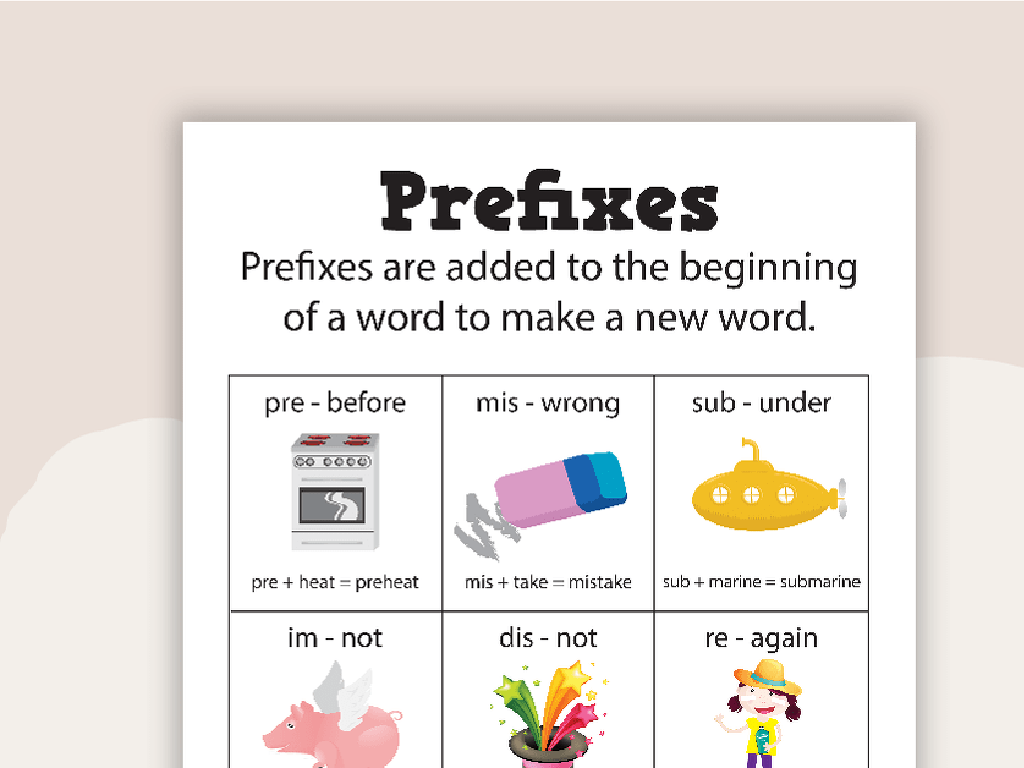Divide By Decimals Without Adding Zeros
Subject: Math
Grade: Fifth grade
Topic: Divide Decimals
Please LOG IN to download the presentation. Access is available to registered users only.
View More Content
Dividing Decimals Without Adding Zeros
– Understand what decimals represent
– Decimals show parts of a whole, like 0.5 is half
– Learn the division process
– Division is sharing equally or grouping
– Divide by decimals, no extra zeros
– Use division strategies without lengthening the number
– Practice with examples
– Try dividing 2.5 by 0.5 or 1.2 by 0.3 together
|
This slide introduces the concept of dividing by decimals without the traditional method of adding zeros to the dividend. Begin by ensuring students have a solid understanding of what decimals represent, using visual aids like pie charts or grids if necessary. Explain that division is essentially splitting a number into equal parts or groups. Emphasize that we can divide by decimals without making the number longer by adding zeros, which can often confuse students. Provide clear examples and work through them step by step, encouraging students to visualize the process. The goal is for students to feel comfortable with this method and to practice it with various examples.
Review: Division & Decimals
– Recap dividing whole numbers
– Understanding decimals
– Decimals represent parts of a whole, like 0.5 is half
– Decimal point in division
– Align decimal points in the dividend and divisor
– Practice without extra zeros
– Use estimation to place the decimal without adding zeros
|
Begin with a quick review of how to divide whole numbers as a foundation for understanding division with decimals. Explain what decimals are and how they represent fractions of a whole, which is a crucial concept for fifth graders to grasp. Then, demonstrate how to correctly place the decimal point in the quotient when dividing by decimals. Emphasize the importance of aligning decimal points and using estimation to find the correct placement of the decimal in the answer, without the need to add extra zeros. Provide examples and practice problems to reinforce the concept. Encourage students to explain their reasoning when placing the decimal point in their answers.
Dividing Decimals by Whole Numbers
– Divide decimals step-by-step
– Example: 3.75 ÷ 5
– How to divide 3.75 by 5 without adding zeros
– Understand each division phase
– Break down the problem into manageable parts
– Solve a practice problem together
– Let’s try 4.8 ÷ 2 as a class activity
|
This slide introduces the concept of dividing decimals by whole numbers without the need to add zeros. Start by explaining the step-by-step process of division as a refresher. Then, present the example 3.75 ÷ 5, showing how to place the decimal point directly above in the answer. Discuss each phase of the division process, ensuring students understand how to bring down digits and when to stop dividing. Finally, engage the class with a practice problem, 4.8 ÷ 2, encouraging them to apply the steps they’ve learned. Walk through the problem as a class, and then allow students to try similar problems on their own or in small groups.
Dividing by Decimals: Understanding the Basics
– How dividing by decimals differs
– Unlike whole numbers, decimals have a ‘point’ to consider.
– Decimal points in division
– The decimal point’s position affects the quotient.
– No need for extra zeros
– Adding zeros can cause confusion; it’s unnecessary.
– Strategies for accurate division
– Use estimation and place value understanding.
|
This slide introduces the concept of dividing by decimals, highlighting the differences from dividing by whole numbers. Emphasize the importance of the decimal point’s position and how it influences the result of the division. Explain that adding zeros to the end of a decimal is not required and can lead to mistakes. Instead, teach students to use estimation and a strong grasp of place value to find the correct quotient. Provide examples and practice problems to solidify these concepts. Encourage students to think about why these strategies work and to verbalize their thought process.
Dividing by Decimals: A Step-by-Step Guide
– Move the decimal point
– Shift the decimal in the divisor to the right end, and do the same in the dividend.
– Divide like whole numbers
– After moving the decimal, divide as if you’re working with whole numbers.
– Check your answer
– Multiply the quotient by the divisor to see if you get the dividend.
|
This slide is aimed at teaching fifth graders how to divide numbers by decimals without adding zeros. Start by explaining the process of moving the decimal point in both the divisor and the dividend to the right until the divisor is a whole number. Emphasize that the same number of moves must be applied to both. Then, guide them through the division process as if they are dividing whole numbers, since the decimal point has been moved. Lastly, instruct them on how to check their work by multiplying the quotient by the divisor to ensure it equals the dividend. Provide examples and practice problems to reinforce the concept.
Dividing Decimals: No Extra Zeros Needed!
– Example 1: Simple decimal division
– Divide 0.6 by 0.2. Move the decimal point, get 3 as the answer.
– Example 2: Complex decimal division
– Try 1.26 by 0.3. Shift decimals, multiply, and find the quotient.
– Understanding why zeros aren’t needed
– Zeros can confuse. Learn to shift the decimal instead!
– Practice makes perfect!
|
This slide aims to demonstrate that adding zeros when dividing by decimals is not necessary and can be avoided by understanding how to shift the decimal points. Start with a simple example, such as dividing 0.6 by 0.2, to show that by moving the decimal point in both numbers to the right, the division becomes a straightforward problem of 6 divided by 2, which equals 3. Then, move on to a more complex example, like 1.26 divided by 0.3, and apply the same principle. Emphasize that the process of shifting the decimal is more reliable than adding zeros, which can lead to confusion. Encourage students to practice with different examples to become comfortable with the concept. Provide additional practice problems for homework to reinforce the lesson.
Class Activity: Divide & Conquer!
– Pair up and solve division problems
– Share solutions with the class
– Discuss strategies used in groups
– Did you estimate? Use long division? Explain!
– Reflect on learning and understanding
– Think about what methods worked best for you.
|
This interactive class activity is designed to reinforce the concept of dividing by decimals without adding zeros. Students will pair up to work through a set of division problems that involve decimals. After solving the problems, each pair will share their solutions and the methods they used with the class. This will be followed by a group discussion where students can compare different strategies, such as estimation versus long division, and reflect on their effectiveness. The teacher should circulate to offer guidance and ensure that all students are engaged. Possible activities include: 1) Estimating before dividing, 2) Using manipulatives to visualize division, 3) Writing out long division step by step, 4) Creating a word problem that leads to the division problem they solved. The goal is for students to understand various methods of dividing by decimals and to recognize which strategies work best for them.
Homework: Mastering Decimal Division
– Take home practice problems
– Preview: Multiplying Decimals
– Get a sneak peek at how to multiply numbers with decimals.
– Tips for successful practice
– Review steps, work slowly, and double-check your work.
– Keep a positive mindset
– Believe in yourself and remember that practice makes perfect!
|
This slide is designed to wrap up the lesson on dividing by decimals and to set the stage for continued learning at home. Provide students with a set of practice problems that reinforce today’s lesson without adding zeros. Introduce the next topic, multiplying decimals, to pique their interest and provide continuity in their learning journey. Offer tips such as reviewing the division steps before starting, taking their time with each problem, and always checking their work to avoid simple mistakes. Encourage a growth mindset by reminding them that every challenge is an opportunity to learn and improve. The goal is to leave students feeling prepared and motivated to tackle their homework and excited for the next lesson.






